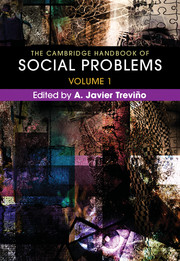Book contents
- The Cambridge Handbook of Social Problems
- The Cambridge Handbook of Social Problems
- Copyright page
- Contents
- About the Contributors
- Introduction
- Part I General Concerns and Orientations in the Study of Social Problems
- Chapter 1 The Challenges of Conceptualizing Social Problems
- Chapter 2 Research Methods
- Chapter 3 Participatory Action Research and Social Problems
- Chapter 4 Public Policy and Social Problems: Recent Trends in the Formal Control of Individual Behavior
- Chapter 5 Social Problems in Global Perspective
- Chapter 6 Bridging Social Movements and Social Problems
- Chapter 7 Public Sociology and Social Problems
- Chapter 8 Service Sociology and Social Problems*
- Chapter 9 Astrosociology: Social Problems on Earth and in Outer Space
- Chapter 10 Prospects for the Sociological Study of Social Problems*
- Part II Historical and Theoretical Issues in the Study of Social Problems
- Part III Problems of Discrimination and Inequality
- Part IV Problems of Institutions
- Index
- References
Chapter 6 - Bridging Social Movements and Social Problems
from Part I - General Concerns and Orientations in the Study of Social Problems
Published online by Cambridge University Press: 16 March 2018
- The Cambridge Handbook of Social Problems
- The Cambridge Handbook of Social Problems
- Copyright page
- Contents
- About the Contributors
- Introduction
- Part I General Concerns and Orientations in the Study of Social Problems
- Chapter 1 The Challenges of Conceptualizing Social Problems
- Chapter 2 Research Methods
- Chapter 3 Participatory Action Research and Social Problems
- Chapter 4 Public Policy and Social Problems: Recent Trends in the Formal Control of Individual Behavior
- Chapter 5 Social Problems in Global Perspective
- Chapter 6 Bridging Social Movements and Social Problems
- Chapter 7 Public Sociology and Social Problems
- Chapter 8 Service Sociology and Social Problems*
- Chapter 9 Astrosociology: Social Problems on Earth and in Outer Space
- Chapter 10 Prospects for the Sociological Study of Social Problems*
- Part II Historical and Theoretical Issues in the Study of Social Problems
- Part III Problems of Discrimination and Inequality
- Part IV Problems of Institutions
- Index
- References
Summary
The history of social movement scholarship reveals that, despite implicit connections between movements and social problems, explicit analytical ties between the two areas remain weak. Consequently, based on the history of movement theory and its relations with social problems, I identify four directions for future research that can strengthen ties between the two substantive areas. First, movement scholars should resituate movements in a wider range of collective civic claimsmaking. Second, scholars should revisit Hilgartner and Bosk's (1988) arenas model of social problem formation as a theoretical foundation for connecting the formation of movement grievances with the social problems. Broadening the application of this theory will better situate scholarship on movements’ multi-institutional politics in groups multiple institutional contexts. Third, future scholarship should strengthen ties between literatures on global social problems and global/international movements. Fourth, research collaborations should strive to develop new methods of studying activism across locations and over time.
- Type
- Chapter
- Information
- The Cambridge Handbook of Social Problems , pp. 99 - 118Publisher: Cambridge University PressPrint publication year: 2018



